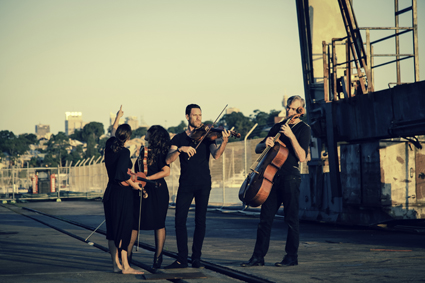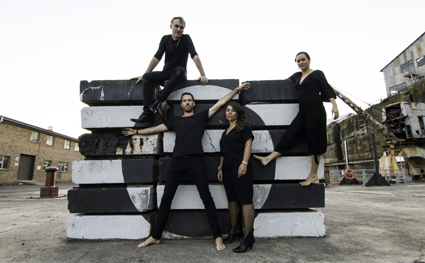Improvisers & composers connect!
Keith Gallasch: interview James Eccles, Composed NOISE

Mirabai Peart, Veronique Serret, James Eccles, Ollie Miller, The NOISE
photo Andrew Wholley
Mirabai Peart, Veronique Serret, James Eccles, Ollie Miller, The NOISE
After six years honing his viola playing skills in Berlin, James Eccles returned to Australia with an unusual ambition—to pursue a career in improvisational music-making in the contemporary classical music idiom and beyond. In the 18th and 19th century musicians and, not least, composers would be expected to publicly extemporize. In a return to tradition, Eccles is however not looking to the past so much as creating new musical possibilities for the future, realised in performances by The NOISE string quartet, which he leads, and its collaborators.
Ambition—and courage—are signalled by The NOISE’s latest venture, Composed NOISE: seven newly commissioned string quartets to be performed over two nights in Sydney’s Cellblock Theatre. These works by Australian composers— Andrew Ford, Rosalind Page, Paul Cutlan, Lyle Chan, Andrew Batt-Rawden, Alex Pozniak and Amanda Cole—“have been created through a collaborative process of workshopping and improvising, where the performers and composers function as equals. In this innovative process, performers become co-writers of the work, through their ability to improvise (or compose in real time)” (press release).
The NOISE
I met with Eccles to discuss Composed NOISE, but first asked about the musical background of the quartet’s players. The NOISE is made up of classically trained violinists Veronique Serret and Mirabai Peart, violist James Eccles and cellist Ollie Miller. Peart also has a busy career playing in the free-improvising Splinter Orchestra, jazz groups and the world music collective Tapestries of Sound. Miller, who plays classical and jazz piano as well as percussion is a member of the jazz group Amphibious. Having played with the Malaysian Philharmonic, the Tasmanian Symphony Orchestra and the ACO, Serret has also been a core member of Ensemble Offspring, was a founding member of the electronic/rock/classical band CODA and plays amplified violin for Inga Liljestrom’s band, elk. Eccles has played with Judy Bailey, DJ Spooky, Sydney Philharmonia Orchestra, Taikoz and Ensemble Offspring among others. With Miller he does an “avant garde rock thing,” performing recently at the VIVID festival in collaboration with electric guitarist Zane Banks. Soon Eccles and Miller will improvise over drones created by Julian Day as part of Day’s Infinity Room project.
The NOISE took shape, says Eccles, “after three of us were inspired by a Necks concert at the beginning of 2008. We found another violinist, started out as very much a little fun project and after several jam sessions said, let’s do a gig. There was a push factor from playing a lot of contemporary music and struggling with notes all the time, which can be great—it’s its own challenge. But we wanted to make our own music, to be creative and get a real kick out of it.”
Dealing wild cards
I ask Eccles about the kinds of improvisation involved in playing the seven quartets in Composed NOISE. He tells me that the degree of improvising varies considerably, from little to much, if in a variety of ways—sometimes where the composer has left space, or one or two players might improvise against the notated playing of the others, or when the composer might specify notes but not some other aspect of realization, like texture. However, for the quartet an important component of Composed NOISE has been the compositional-collaborative process. “I’ve had various meetings with the composers, starting last year. Lyle Chan based his piece on the blackjack card game. I liked the idea but then thought, hang on, we’re a quartet let’s have a real four-person game and immediately thought of bridge and 500.
“So we play a game of 500 before we perform the piece and that becomes the score. Lyall did a really good job finding a balance between what the cards stipulate and adding other instructions on top of that. There are 10 tricks in a hand of 500, so it’s a 10-movement piece and each trick has a specific instruction—glissando, pizzicato non-vibrato etcetera. Particular cards carry instructions: suits dictate register—hearts is the highest—and a number card will dictate certain rhythmic or grouping parameters. The face cards are complex and solo-istic, so the stronger the card, the stronger your part, while a number card will suggest a more accompanying role.”
As well as having to learn these rules, the players have to handle another quite lateral stipulation: “that the person who leads off the trick leads off the movement; but before they play they have to think of a type of weather, hence the work’s title, Smoke Weather Stone Weather. You don’t tell anyone what you’re thinking, they just react to what you’re playing. So that’s a real curve ball.
“For the purpose of the first performance we’ll video the game the day before, given all the logistics we have to get our heads around. But it won’t be rehearsed. It’ll still be spontaneous. Lyall’s piece is the most like what we do as The NOISE, reacting in the moment. We’ll probably do it many, many times.”

Ollie Miller, James Eccles, Veronique Serret, Mirabai Peart, The NOISE
photo Andrew Wholley
Ollie Miller, James Eccles, Veronique Serret, Mirabai Peart, The NOISE
Improvisation by degrees
Paul Cutlan’s contribution, Merge/Emerge, will also involve ample improvisation in a work “rooted in rhythm and harmony, in the tradition of Shostakovich and Britten, and with one delicious jazz moment when it comes.” The kinds of improvisation indicated in the score vary: “three of us will play the score with one player improvising, or there’ll be a bridging section with two people improvising and then we all come in and play a notated page and then one of us goes to a solo. Paul is a performer himself and really knew what we wanted to engage with and he knows the balance of how much to write and not write.”
Andrew Batt-Rawden has created “28” in which, says Eccles, the composer is “video-ed live writing the music—some of it pre-written over which he’ll overlay other elements as we play.” Alex Pozniak’s Force Fields, for amplified instruments, “ends with screaming feedback—a logical conclusion to a very intense piece. Some will love and some will hate it. It deserves to be picked up by other quartets. It’s more interpretive for us than improvisatory—Alex knows what he wants—but you have to determine how you might, say, make a stuttering effect on scratch tones.” Rosalind Page, Eccles tells me, “wrote her Master’s Thesis on Tarkvosky. Ollie’s also a big fan. I wasn’t convinced at first but now I’m a fan of The Mirror [1975], the film that’s inspired Rosalind’s piece, Zerkalo (Mirror). The film is autobiographical, about a father leaving his family, so each instrument plays a character—mother, child, father, poet—in musical dialogues. It’s hauntingly beautiful. Tarkovsky himself used soundscapes and music so strongly, referencing Bach. We’ll be improvising around some of the Pergolesi Stabat Mater.”
The other works in Composed NOISE are Amanda Cole’s Ecliptica and Andrew Ford’s String Quartet No 4, plus a bonus work by The NOISE themselves in the first concert of the two-night program. Ford’s composition was commissioned by Julian Burnside, while the other quartets were commissioned with funds from the Australia Council and those raised by The NOISE and Chronology Arts.
Ambition and freedom
Finally, I ask Eccles how ambitious he is for The NOISE. He laughs and says “Very!” But it’s no easy task given how busy the quartet members are. The goal is to work together one to two months a year, ideally on a major project like Composed NOISE but with an expanded palette that might include “a world music focus or an electric work or a studio album with overdubs.”
As for recordings, Composed NOISE will soon be available on CD and The NOISE has been recording Sydney-based composer George Lentz’s String Quartets—seven hours of it on NAXOS BluRay (apparently the only way to conveniently issue such a huge work). “It’s quite extraordinary playing beautiful chorale writing and improvising, providing source material for the mix—all tremolo, say, or all glissando. When we thought we were finished, George called to say he needed one more chorale section! It’s an installation work, but it might become a live performance,” says Eccles, apparently more excited than daunted by the work’s length.
I wonder if, after six years in Berlin, Eccles is happy working in Australia. He’s emphatically positive. “In Berlin it was mostly about learning to play the viola rather than being really creative—the good violist getting my viola chops up to work in an orchestras. I went to lots of Arditti Quartet concerts, but didn’t do much contemporary playing myself; it was mostly with orchestras doing Mozart and Beethoven. Here I’m a bit bigger fish in a smaller pond, I know the people, it’s my scene. I want to make things happen. It’s patriotic. I want to do things for Australian music. I’m inspired by nature and the sense of freedom here among my fellow collaborators.”
IMPORTANT NOTE: Due to a unforseen circumstances, the Composed NOISE concerts have had to be cancelled.
The CD Composed NOISE is now available on iTunes
For more information, www.thenoise.com.au; www.vexations840.com.
RealTime issue #116 Aug-Sept 2013 pg. web






